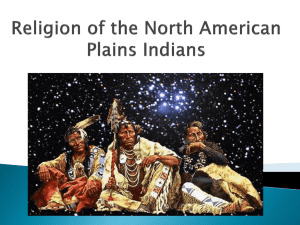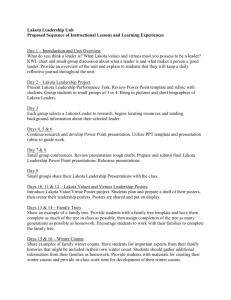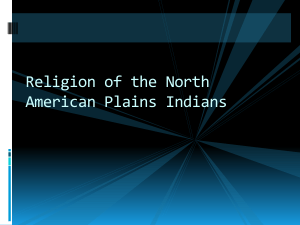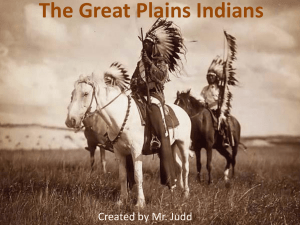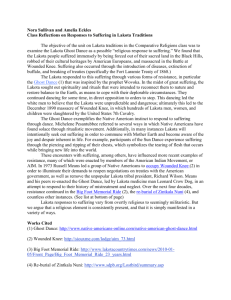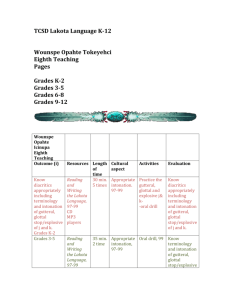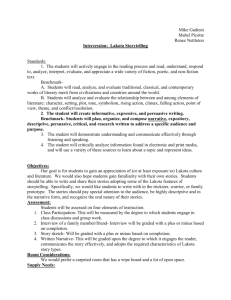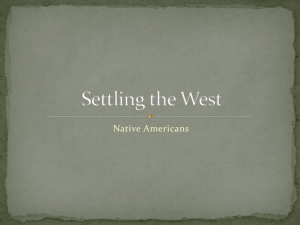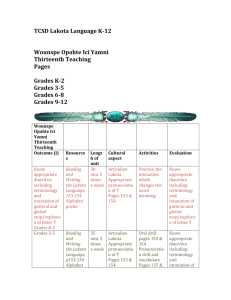OCETI SAKOWIN
advertisement
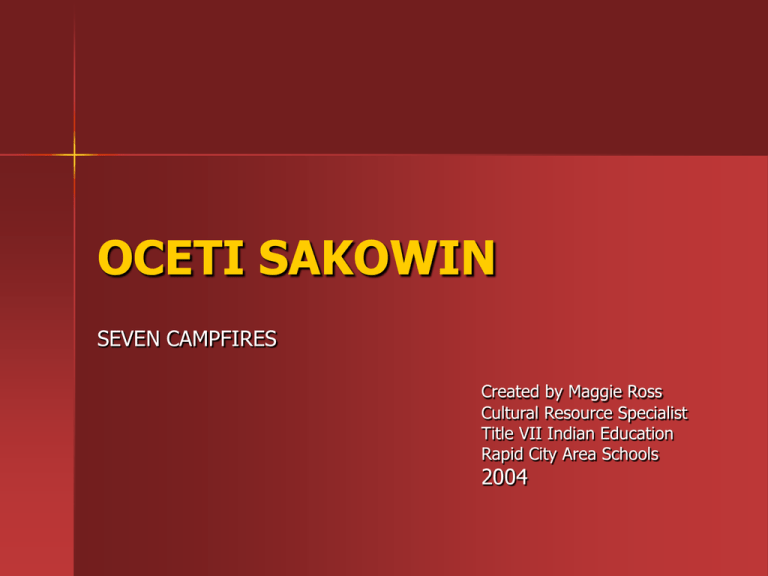
OCETI SAKOWIN SEVEN CAMPFIRES Created by Maggie Ross Cultural Resource Specialist Title VII Indian Education Rapid City Area Schools 2004 OCETI SAKOWIN Original form of governance of the Lakota/Dakota/Nakota speaking people. Territory of the Oceti Sakowin consisted of the majority of the Great Plains OCETI SAKOWIN Isanti (Santee) Dakota Mdewakantonwan: People of Spirit Lake Wahpetonwan: People among the leaves Wahpekute: Shooters among the leaves Sisitonwan: People of the Swamp The Dakota dwelling place was to the east and north east in the lakes region within the vast territory that the Oceti Sakowin commanded. The majority of the economy centered around fishing and the harvesting of wild rice and herbs. They were recognized as the people of the herbs. OCETI SAKOWIN Yankton Nakota Ihanktonwan: Campers at the End Ihanktonwanna: Little Campers at the End The Nakota resided to the south and southeast within the Oceti Sakowin territory. Their economy centered around pipestone quarrying, and they were known and recognized as the care takers and protectors of the pipestone quarries. OCETI SAKOWIN Titonwan (Teton) Lakota Oglala: Scatter their own Sicangu: Burnt Thighs Hunkpapa: End of the Horn Entrance Mniconjou: Planters by the water Oohennunpa: Two Kettles Itazipacola: Without Bows The Lakota were known as the people of the prairie and the Pte Oyate (Buffalo People). They resided to the west, northwest and the southwest of the Oceti Sakowin Territory. Their economy was based on the buffalo, wild fruits and vegetables. They are also recognized as the care takers of He Sapa (the Black Hills). OCETI SAKOWIN Governance System was complex – “When a formal camp is made it is circular with the entrance towards the rising sun and the place of honor at the opposite side facing the entrance. When all the Lakotas were associated in one camp, each tonwan placed its tipis together and built its camp fire. By common consent the original tonwan was given the place of honor and the others were arranged as agreed upon. But the Tetons became powerful and warlike and they usurped the place of honor which had been given to the Blewakantonwan, [Mdewakantonwan]…” (Source: Lakota Society. Divisions of the Lakotas. James R.Walker.) OCETI SAKOWIN Titonwan Mdewakanton Wahpetonwan Wahpekute Sisitonwan Ihanktonwan Ihantonwanna Formal Camp Circle OCETI SAKOWIN Each band had a leader (itaca), usually called ‘chief’ in English, who spoke for his people. The council, comprised of respected adult men, represented the people of the camp. As men came of age and achieved status in the community they were invited to sit in the council. Their discussions concerned everything related to the common welfare: camp moves, relations with other camps and with Whites, and when and where hunting parties should be sent. They also approved war parties before they set out and arbitrated disputes between camp members. (Source: Lakota Society. Divisions of the Lakotas. James R. Walker) OCETI SAKOWIN The Oglala sat in the place of honor. Each camp, village, or family had a variety of societies who were in charge of specific functions of life. The political structure also maintained its order. Each subgroup of the Titonwan also broke down into sub groups for example the Oglala broke down to seven tiyospaye (extended family). The tiyospaye also resembled the structure of the Oceti Sakowin. The tiyospaye was created by several tiwahe’s (household or immediate family). These tiwahe’s came together in form of bloodline relationships or mutual agreement of non-related tiwahe’s who supported that particular tiyospaye. “Membership in a tiyospaye was a matter of choice, not descent. Individuals were considered to belong to the lodge group in which they were born, but they were free to leave and join another lodge group at any time.” (Source: Lakota Society. Divisions of the Lakotas. James R. Walker) OCETI SAKOWIN Each tiyospaye had seven positions that were nominated through the tiwahe process. Each position was held for a one year period. These positions were held in each organization from the tiyospaye to the Oceti Sakowin. Decision making and mediation was made through this process. OCETI SAKOWIN The Tiospaye Omniciye is represented by three Tiospaye officers which were appointed by the Omniciye: Akicita (warrior), Wakiconzas (leader when tribe is in movement) also known as shirt wearers, and Wicasa Yatapikas (chief). The Omniciye also appoints Omniciye Officers: Pipe Keeper, Staff Keeper, Fire Keeper and Drum Keeper. (Source:GOF:pl 1/27/95 Tiospaye Omniciye) OCETI SAKOWIN The Tiospaye Omniciye is at the center of the government. The Lakota believed in this strongly without the people or families then there was no government or support. (Source: Gerald One Feather) OCETI SAKOWIN Seven responsibilities of the Omniciye – 1. Omniciye is the Tiospaye Oyate exercising their sovereignty. – 2. Omniciye execises legislative responsibility and establishes policy by unanimous consent. – 3. Omniciye appoints Tiospaye Officers: Akicitas, Wakiconzas, Wicasa Yatapikas. – 4. Omniciye appoints Omniciye Officers: Pipe Keeper, Staff Keeper, Fire Keeper, Drum Keeper. – 5. Omniciye decides matters of great importance that affects all tiospaye members. – 6. Omniciye supports children’s growth through honoring ceremonies. – 7. Each Tiospaye is an autonomous economic unit and Omniciye controls all economic activities under their jurisdiction” (Source: GOF:pl 1/27/95). OCETI SAKOWIN the tiospaye is the family man and woman and each had a value. – Ikte Wicasa (common man): wacante oonaka –ability to endure, ohitika- ability to defend, wacin ognaka-control of mind/spirit, nagi skapi-wise spirit-vision quest-ability for wisdom which comes from above. – Ikte Winyan (common woman): wacin ognaka-people in her heart she lives for other people, ohitika-woman only person to carry in the camp a knife to defend or to feed (this also symbolizes head of household, respect), wakanheja-responsibility for the next generation. Children are brought up to repeat-to be our future leaders to carry on, wacekiyapi- responsibility to pray for the family (she owns the tipi, wiyapahice-the center pole). A medicine man at his alter has a center pole; woman’s spirit that invokes the spirit to come in. (Source: Gerald One Feather) OCETI SAKOWIN It is important to understand the significance of this governance and how the interference of the United States government has negatively impacted the sovereignty and life of those people who existed under the governance of the Oceti Sakowin It is also important to understand that the Lakota/Nakota/Dakota and many other tribes had a form of government that were not patriarchal. Women were considered an important part to society, because they were and are the life bearers. Resources Cradle Board Teaching Projects. http://www.cradleboard.org/main.html Dakota Conflict WebQuest. http://1862.nativeweb.or/index.htm Government. http://www.olc.edu/culture/oglala-culture/government.htm K-2 Standards & Benchmarks. http://www.wambdi.bia.edu/k2%20Standards.htm. Lakota na Dakota Wowapi Oti Kin. http://puffin.creighton.edu/lakota/index.html. Lakota Teaching Project. www.leinroth.com/lakota/home.htm. One Feather, Gerald. Tiospaye Omniciye. Native American Indian Resources. www.kstrom.net/isk/mainmenu.html. Sioux Nation. Lakota-Dakota-Nakota. http://www.crystalinks.com/sioux.html. 3-5 Standards & Benchmarks. http://www.wambdi.bia.edu/35%20Standards.htm. Walker, James. Lakota Society Divisions of the Lakotas. University of Nebraska Press; Lincoln, NE. 1982. I hope you enjoyed the presentation Toksa…

